|
Earth & Space
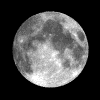
What you should know.
- The sun appears to rise
in the east and set in the west.
- The Earth turns on its
axis once in 24 hours (1 day).
- The Earth travels around
the Sun in an orbit taking 365.25 days (1year).
- The Earth's axis is
tilted 23.50. This means that in summer the Sun is higher in the
sky and the days are longer and warmer than in winter.
- The Moon moves round the
Earth, taking 1 month to complete the orbit.
- The moon shines because
of reflected sunlight. It shows different phases at different times of the
month.
- In an eclipse of the
Moon, the Moon moves into the Earth's shadow and so it goes dark. in an
eclipse of the Sun the Moon is between the Earth and the Sun so the sky goes
dark.
- There are 9 planets. In
order they are: Mercury, Venus, Earth, Mars, Jupiter, Saturn, Uranus,
Neptune and Pluto.
- The planets are held in
their orbits by the Sun's gravity. The shape of each is an ellipse.
- The planets are at
different temperatures because they are at different distances from the Sun.
Pluto is the coldest, and mercury is the hottest.
- Jupiter, Saturn, Uranus
and Neptune are 'Gas Giants'. The have rocky surfaces.
- The Sun is a star. It is
part of the our galaxy, called 'The Milky Way'.
- Some galaxies are spiral
in shape. There are billions of galaxies in the universe.
- A light-year is the
distance that light travels in one year.
- The Universe is
expanding. It has getting bigger ever since it started, in the 'Big Bang'.
In this module we find out all about our solar system
and stars and galaxies. We learn how we have seasons, and why a year is 365 days
(and a quarter!) and lots of interesting stuff.
I love this section!!!!!
Have you ever wondered why a day is 24 hours long, or a
year 365 days or what a leap year is about? Well no need to any more. The
answers are here. Read on.
We live on the planet Earth which is a small rocky
planet that rotates around a star which we call our sun. Earth spins on its axis
and one full spin takes 24 hours ( a day). When the bit of the earth we are
standing on spins away from the sun we say it is night because it is dark. When
we are facing the sun it is light and we call that the day. Easy so far!
The earth revolves around the sun and when it has gone
all the way around and is back where it started we say a year has passed. This
takes 365 (and a quarter) days. We add the quarter days together and every four
years (a leap year) we add an extra day to our calendar!
Below are some links and pictures to help you with your
studies:-
The Earth
Beneath the crust, the Earth is a sphere of hot rock and metal. By studying
the records of earthquake waves, scientists have learned that the inside of the
Earth is divided into three parts: the mantle, the outer core, and the inner
core. The mantle is a thick layer of rock below the crust. It goes down about
1,800 miles (2,900 kilometers). The rock in the mantle is made of silicon,
oxygen, aluminum, iron, and magnesium. The uppermost part of the mantle has a
temperature of about 1600 degrees F (870 degrees C). The temperature gradually
increases to about 8000 degrees F (4400 degrees C) in the deepest part of the
mantle.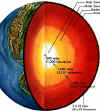
The outer core begins about 1,800 miles (2,900 kilometers) below the Earth's
surface. Scientists believe the outer core is about 1,400 miles (2,250
kilometers) thick and consists mainly of melted iron, combined with a small
amount of some other elements, most likely oxygen or sulfur. Its temperature
ranges from about 8000 degrees F (4400 degrees C) in the uppermost parts to
about 11,000 degrees F (6100 degrees C) in the deepest parts.
Seasons
The changing seasons are caused by the changing
position of the Earth in relation to the sun. Astronomers can tell exactly from
the Earth's motion around the sun when one season ends and the next one begins.
The dates used for the first day of each season mark the beginning of the
astronomical seasons. The beginning and end of the climatic seasons vary from
these dates from place to place and from year to year. The temperature and
weather do not change instantly in response to the changing position of the
Earth in relation to the sun. The warmest and coldest weather generally occurs
several weeks after the beginning of the summer and winter astronomical seasons.
 Heat
that has been retained by the oceans plays an important role in producing this
delayed response. The seasons keep changing because the tilt of the Earth's axis
never changes while the Earth circles the sun. One way to understand this is to
picture which way the tilt of the axis causes the North Pole to slant at
different times of the year. Heat
that has been retained by the oceans plays an important role in producing this
delayed response. The seasons keep changing because the tilt of the Earth's axis
never changes while the Earth circles the sun. One way to understand this is to
picture which way the tilt of the axis causes the North Pole to slant at
different times of the year.
When the North Pole slants toward the sun, the Northern Hemisphere receives the
most sunlight and it is summer there. When the pole slants away from the sun,
the Northern Hemisphere receives the least sunlight and it is winter. Spring
begins when the pole starts to slant toward the sun, and autumn begins when the
pole starts to slant away again.
Moon
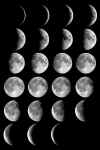 This
is a photograph showing the actual phases of the moon. Cick on it for a better
look. Note how the moon shows the same face to the Earth at all times. You
can see the moon really well with binoculars. Try it! This
is a photograph showing the actual phases of the moon. Cick on it for a better
look. Note how the moon shows the same face to the Earth at all times. You
can see the moon really well with binoculars. Try it!
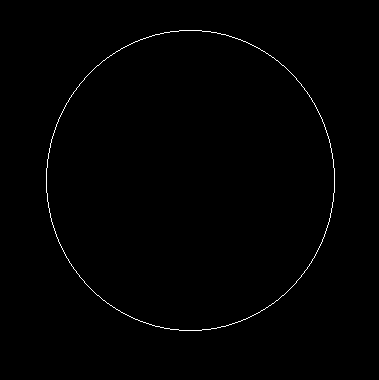 |
New Moon -
The Moon's unilluminated side is facing the Earth. The Moon is not
visible (except during a solar eclipse). |
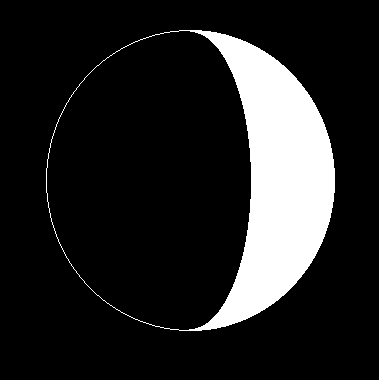 |
Waxing Crescent - The Moon appears to
be partly but less than one-half illuminated by direct sunlight. The
fraction of the Moon's disk that is illuminated is increasing. |
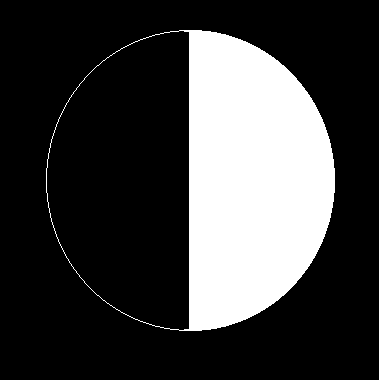 |
First Quarter - One-half of the Moon
appears to be illuminated by direct sunlight. The fraction of the
Moon's disk that is illuminated is increasing. |
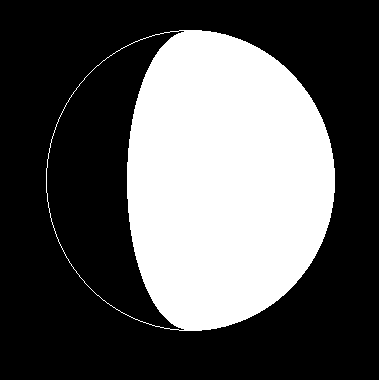 |
Waxing Gibbous - The Moon appears to be
more than one-half but not fully illuminated by direct sunlight. The
fraction of the Moon's disk that is illuminated is increasing. |
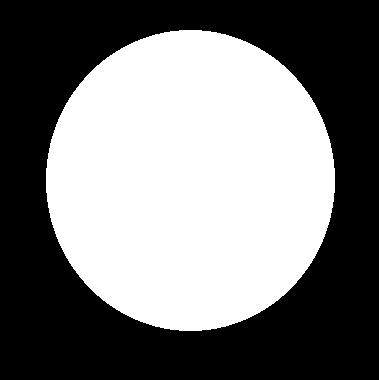 |
Full Moon - The Moon's illuminated side
is facing the Earth. The Moon appears to be completely illuminated by
direct sunlight. |
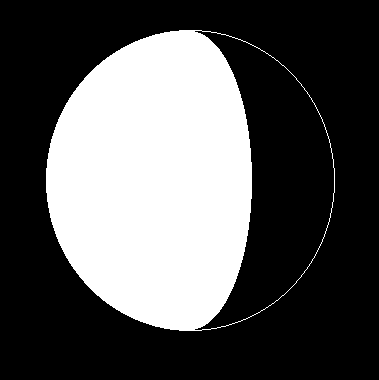 |
Waning Gibbous - The Moon appears to be
more than one-half but not fully illuminated by direct sunlight. The
fraction of the Moon's disk that is illuminated is decreasing. |
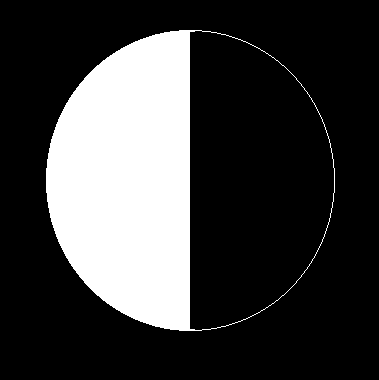 |
Last Quarter - One-half of the Moon
appears to be illuminated by direct sunlight. The fraction of the
Moon's disk that is illuminated is decreasing. |
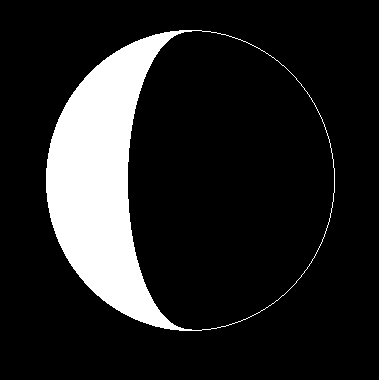 |
Waning Crescent - The Moon appears to
be partly but less than one-half illuminated by direct sunlight. The
fraction of the Moon's disk that is illuminated is decreasing. |
The following waning crescent is a New Moon, beginning
a repetition of the complete phase cycle of 29.5 days average duration. The time
in days counted from the time of New Moon is called the Moon's "age".
Each complete cycle of phases is called a "lunation"
***** The Islamic calendar is based on lunar months,
which begin when the thin crescent Moon is actually sighted in the western sky
after sunset within a day or so after New Moon. The 12 months of the Islamic
calendar are: Muharram, Safar, Rabi'a I, Rabi'a II, Jumada I, Jumada II, Rajab,
Sha'ban, Ramadan, Shawwal, Dhu al-Q'adah, Dhu al-Hijjah. Since 12 lunar months
are, on average, 11 days shorter than the calendar we use (Gregorian), the
Islamic year shifts earlier in each year by about this amount. The count of
years for the Islamic calendar begins in 622.
Solar System
This our sun and all the planets that revolve around
it. Cool!
| |
Sun |
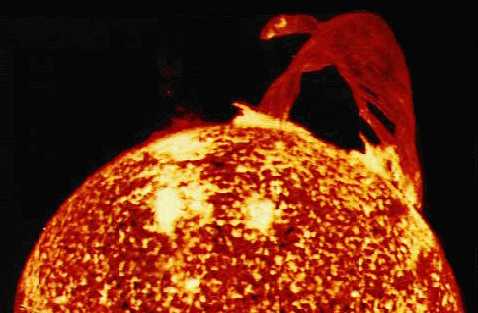 |
| My |
Mercury |
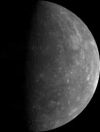 |
| Very |
Venus |
 |
| Educated |
Earth |
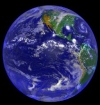 |
| Mrs |
Mars |
 |
| Arnold |
Asteroid Belt |
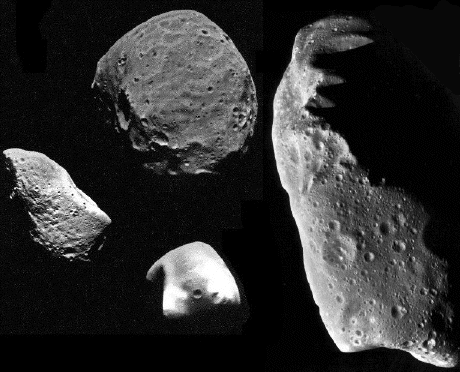 |
| Just |
Jupiter |
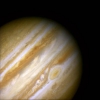 |
| Showed |
Saturn |
 |
| Us |
Uranus |
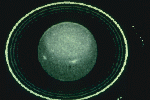 |
| Nine |
Neptune |
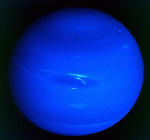 |
| Planets |
Pluto |
 |
Sites to help you:-
Internet sites to try include the online observatory at www.jb.man.ac.uk;
animated eclipses at www.nmsi.ac.uk/eclipse/eclipselab/
and planets of the solar system at www.nasa.gov
http://www.teelfamily.com/activities/aurora/nightsky.html
http://www.astro.auth.gr/ANTIKATOPTRISMOI/nineplanets/nineplanets/nineplanets.html#toc
http://www.nss.org/apollo/
http://www.worldbook.com/fun/seasons/html/seasons.htm.
http://www.tcsn.net/afiner/intro.htm
www.bbc.co.uk/planets.
http://www.fourmilab.ch/earthview/
http://top.ngfl.gov.uk/featureweek10.php3?f=0
virtual solar system
http://www.nationalgeographic.org/solarsystem/
http://www.nationalgeographic.org/solarsystem/splash.html
What you should be able to
do.
- Use a ball and a lamp to
show why we get day and night.
- Use a ball and a lamp to
show the earth's journey round the Sun, and what is meant by a year.
- Use a ball and lamp to
explain the seasons, including why summer is warmer than winter.
- Use a ball and lamp to
show the phases of the Moon.
- Keep a record of the
Moon's phases over a month.
- Use a lamp and two balls
to an eclipse of the Moon.
- Use a lamp and two balls
to show an eclipse of the Sun.
- Plan an investigation to
see what changes the size and shape of craters.
- Make a scale model of the
Solar System.
- Analyse data about the
Solar System.
- Discuss the arguments for
and against space travel.
- Explain the meanings of
the words: planet, Solar System, star, constellation and galaxy.
- Cut out and sort into
order some pictures to show our place in the Universe
- Make a telescope from two
lenses.
- Plan the contents of a
space capsule.
|
